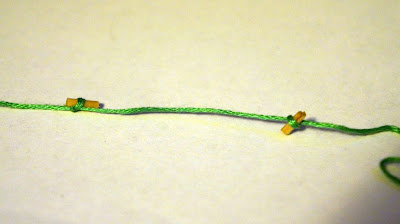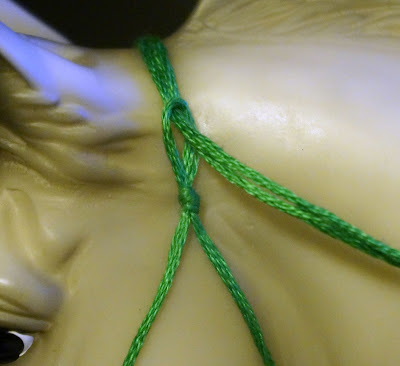Back in March, I thought I had. However, I was only half right. That area IS perpetually soggy, because it's being fed by the spring. I was concerned and ready to abandon the spring idea when I saw the area covered in trash and jars. Even now, as I walk around it, the ground groans beneath my feet and I have to tread lightly, because I'm not walking on solid dirt: I'm walking - literally - on glass. Full jars now make up the ground around that area, and one wrong step can send your foot and ankle gushing blood.
Well, the night before last, dad tipped me off about the actual spring. "Tammy's mom (Tammy's our neighbour) asked us if she could fence that area in for her cows. Just look for the fence. There's an area where a tree fell on it, and you can just step over it there. It's in there," he'd said. I knew exactly where he was talking about; a while back I had seen donkeys behind that fence, so I assumed that was Tammy's land. I brought this up with him, and he assured me that was our land, we were just letting her use it.
So yesterday I headed out to find that fence.
As I headed toward the entrance to the trail, one of my neighbour's dogs approached me. She's one of the mellowest, sweetest, and fattest dogs I've come across. She was friendly and loved the scratches and pets I was giving her. When I was done giving her attention, I headed in to the woods, only to notice I had a shadow. She followed me the entire way to the spring, mostly lagging behind, but she also showed me some of the easiest ways around the thorn bushes, and even showed me the way back out. I enjoyed her company, and I'm sure she enjoyed mine.
Together, we found the fence my dad had told me about, and ventured on. As I picked my way through the brush, I noticed down the hill, a pond. At first, I thought it could be the spring. But then, I recognized the area it was in - though I had never been there, myself. It's up the road past the cobb house at the base of the property. Cobb's pond, I thought. I remembered papaw telling me the spring feeds a pond the Cobbs had built, and as a result, I may only be able to find it with my feet.
My feet. I knew he meant I would get my feet soaked when I found it, but I had another thought. If the spring is feeding a pond, then there has to be a stream leading down to it. I looked down, and sure enough, a few feet in front of me, hidden under the leaves and weeds, was a clear, trickling stream that was flowing down toward the pond.
I let the dog know we were moving and held a bush out of the way so she could walk ahead, before following her in the opposite direction, up-stream, of the pond. It didn't take long after that to find it. She walked straight up to a puddle and dropped her nose to it, gratefully lapping up a few drinks.
I had a roll of ducttape around my wrist, and a broken narrow tree (which I will refer to as a branch), as well as a sleeve of lime green muslin in my hand. Dad had told me to mark the spring with something bright when I found it, so we could find it easily later. I had thought about marking this spot, but decided to try and find the center. Besides, I hadn't gotten my feet wet yet, and I wanted to see how wide this thing was.
I took a step to my left, and immediately, icey water crept through the fabric of my shoe. "That's definitely it," I had said aloud, as if I needed to confirm it with myself. At this point, I decided, "to hell with it," and trudged through the mud and water to find the center. I took the branch and shoved it as far into the mud as it would go, and then slipped the sleeve of muslin over the top of it, securing it with ducttape. I wrapped the top in ducttape, too, to keep it from rotting too quickly. After all, when's the next time I'll be over there? I wanted it to last a few months, at least.
I took a step to my left, and immediately, icey water crept through the fabric of my shoe. "That's definitely it," I had said aloud, as if I needed to confirm it with myself. At this point, I decided, "to hell with it," and trudged through the mud and water to find the center. I took the branch and shoved it as far into the mud as it would go, and then slipped the sleeve of muslin over the top of it, securing it with ducttape. I wrapped the top in ducttape, too, to keep it from rotting too quickly. After all, when's the next time I'll be over there? I wanted it to last a few months, at least.
At this point, I was done, and the dog knew it. She looked at me, and then left. I watched her, seeing the route she took. I would follow this same way later. I just had a few more photos to take.
We weren't far from the original path. Actually, we were just beyond the trash seen in an earlier photo. Luckily, the spring was unaffected, though I'll get it tested to make sure any toxins didn't leech into it. It definitely looked, and smelled, clean, though, (the leaves make it seem darker than it is) and my family swears on its purity. Still, I'd rather be sure, than take the words of people who drank from it potentially 26 years ago.
If it is clean, though, this is excellent news!








































































